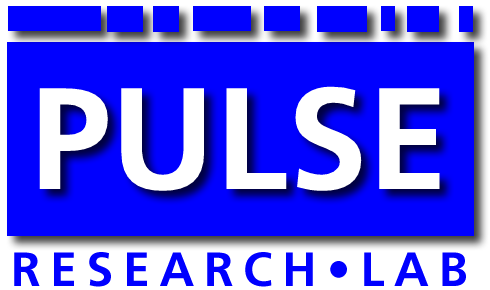Laser Synchronization
Laser Synchronization Solutions:

Read our article in Laser Focus World.
Laser engineers and physicists worldwide use Pulse Research Lab's affordable, ready-to-use solutions for common laser timing applications. PRL modules are ready-to-use, out of the box, with BNC or SMA I/Os, AC adapter, and optional mounting brackets. They are simple enough to use that the "documentation" consists of the top decal on the units, so there is no manual to read or lose. Prices start as low as $380 for U.S. delivery.
Frequency division for synchronizing laser systems
Synchronization of components in a laser system can often be achieved by dividing down a common reference frequency by different ratios. The natural resonant frequency of a laser cavity oscillator can be divided by thousands or millions to drive a flash lamp, seed laser, or other regeneration source synchronously at kHz or even Hz. Or a 10 MHz rubidium frequency standard can be locked to pulse a laser precisely at 10 Hz. Or a GHz RF source can be divided by several million to pulse a diode in the kHz with precise phasing relative to the RF.
Our laser customers demand high frequency, large division ratios, and low jitter. Our edge-triggered designs produce extremely low jitter with very wide operating ranges (DC to fmax, except for the AC-coupled PRL-257-8). Ratios can be fixed or programmable from f/2 up to f/10000, and multiple units can be cascaded for ratios into the millions. Popular models include:
- PRL-260BNT, 2-Phase Programmable NECL/TTL Frequency Divider, f/2 - f/4096
- PRL-257-8, 12 GHz, Programmable 2-Φ divider, f/8-f/128
- PRL-255N, NECL divider, ÷2, ÷4
- PRL-220A, TTL divider, ÷2, ÷4, ÷8, ÷16
- PRL-230, TTL divider, ÷10, ÷100, ÷1000,÷10,000
Independent review shows 1-sigma RJ of less than 1 ps for the PRL-257-8:

Fig. 1: PRL-257-8 Jitter Performance*, 10.3125 GHz clock divided by 64
Sine wave to square wave conversion for laser triggering
Frequency sources are often supplied as sinewaves, whereas trigger inputs often require logic-level square waves. Furthermore, the slow slew rates of sinewaves can often degrade jitter performance, especially if the signals are teed or branched off to multiple receivers. PRL offers variety of ways to convert sinewave to square waves with fast, low-jitter edges and logic-level compatibility to drive your trigger inputs.
Nearly All PRL units with ECL-structured input can be driven by AC-coupled sinewaves with minimum amplitudes of 200 mVpp.
For recovering smaller signals we offer comparator inputs with sensitivity as low as 10 mVpp.
Sine- to square-wave conversion is available with or without frequency division. Popular models include:
- PRL-255CN, Small-signal frequency divider (f/2 & f/4), NECL outputs
- PRL-350ECL, 2 Channel Comparator with NECL Outputs
- PRL-350TTL, 2 Channel Comparator with TTL Outputs
- PRL-434A, 1:4 ECL Fanout Buffer
There are many, many ways to configure one or more PRL modules to handle sine- to square wave conversion. Please email support@pulseresearchlab.com for pre-sales support or application assistance.
Line drivers and Fanout Buffers for pulse regeneration and transmission
Many timing signals in a laser system will not drive a 50 Ω load. For example the photodiode output of a laser cavity oscillator is often a weak pulse with no drive capability. Other signals will not make the appropriate logic-levels into a load, and/or will not drive any appreciable length of cable.
Multiple copies of a trigger signal are often needed for scope triggering, measurement/monitoring, triggering of cameras and data acquisition systems, etc. High-speed pulses cannot be simply teed off or split without dividing the signal amplitude unacceptably.
PRL offers a variety of line drivers for generating TTL, NECL, PECL, LVPECL, or RS422 signals from your timing source, even if your source has limited drive capability. All models are transmission-line drivers and will drive long cables. Fanout modules produce multiple, logic-level compatible copies of your timing signals with low skew and 50 Ω drive capability.
- PRL-350ECL, 2 Channel Comparator with NECL Outputs
- PRL-350TTL, 2 Channel Comparator with TTL Outputs
- PRL-434A, 1:4 ECL Fanout Buffer and Line Driver
- PRL-414B, 1:4 TTL Fanout
- PRL-444, 4 Ch. High Input Impedance TTL Line Driver
If you don't see the signal type you need here, please email support@pulseresearchlab.com for information about our logic-level translators or for application assistance.
Narrow Pulse Generation
Often in conjunction with frequency division is the requirement to preserve or regenerate a narrow pulse. This can be accomplished via "pulse picking," to preserve the original width of the laser "seed" pulse, or by generation of a new pulse of arbitrary narrow width. In both cases the narrow pulse is perfectly synchronized with the original pulse and the divided frequency, because everything is edge-triggered. Click the diagram for more details:
Laser diode drivers
PRL also offers an adjustable pulse driver, the PRL-470B, which will has a maximum amplitude of 8 V delivered into 50 Ω, and has a rise-time of <800 ps (5 V into 50 Ω). The Hi and Lo levels are pot-adjustable for ease of experimentation in the lab, and a 10-turn pot model is available for high-precision applications. The unit accepts TTL or ECL inputs and will toggle up to 300 MHz. A separate trigger output facilitates measurement and monitoring on an oscilloscope or triggering other equipment.
* These test results, though typical, are not guaranteed performance specifications.

